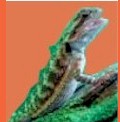Bearded Dragons need a large enough habitat to allow for a variety of distances from the heat source. A glass aquarium is recommended for security, ease of maintenance, and pet viewing. To avoid the expense of multiple habitats as your pet grows to adulthood, consider using a partition that can be easily adjusted. This way, throughout the life of the pet, you can use a single large aquarium, 55-70 gallons.
The white melamine is a material that keeps the cage very bright which is important for stimulating a dragon's appetite. The light (and the UVB) stays inside the cage rather than escaping through the glass sides of an aquarium. Glass fronts will allow the dragon to check out their world and interact with you.
Where To Place The Cage?Find a place, on a stable stand or table, where you feel comfortable and where you can watch anytime your little fellow, against a wall. Try to house your dragon somewhere interesting for him or her, but away from high traffic areas and out of direct sunlight. Do not hide the cage away in a seldom frequented place. Bearded Dragons have a big curiosity. They like to be somewhere where they can watch anytime to their human fellow doing their funny things.
The cage need to be organized with a basking light at one end of the tank, another end should be kept as a cooling area; a hide area of branches and potted non-toxic plants, or a hide box in the tank is also necessary; a rock or log for the basking area. Try to improve the animal environment and remember that the more you do to arrange a Beardie's environment to provide security, the quicker the animal will adjust to its new home and family. Animals that are housed correctly and stress free will remain healthy, eat well, be happier, remain active and alert.
The first days in his new habitat can cause a lot of stress to the Dragon, and because of this they could refuse to eat for some days. To help them accommodate you should:
![]() Use the first weeks to only watch the dragon and learn the behaviors and feeding habits. Read books on Beardies. Your children will want to play with their new friend. Do not allow anybody to pick up the dragon at this moment.
Use the first weeks to only watch the dragon and learn the behaviors and feeding habits. Read books on Beardies. Your children will want to play with their new friend. Do not allow anybody to pick up the dragon at this moment.
![]() For a while you can cover the cage with some milky white panes which won't let the Dragon see to many things outside.
For a while you can cover the cage with some milky white panes which won't let the Dragon see to many things outside.
Babies and small juveniles can be temporally housed in a 10 - 20 gallon aquarium. Young Beardies less than 10 inches in length need to be housed in a 20 gal long aquarium. This will last them for a few months only though as they grow quickly. You can use Profile Extended Storage Bins. The milky white sides of the bins prevent the dragon from becoming terrified in new surroundings and not eating for the first few days, which can become a serious problem.
It is important to judge the correct size of the enclosure. While the dragon is small, it's helpful to keep cage furniture to a minimum, so that they can find their food easily. Crickets can hide in deeply grooved logs or under the furniture making it difficult for a baby dragon to locate food. The dragon won't find them, so will not be able to eat, and the crickets will come out at night and nibble on beardies, who sleep quite soundly, stressing them (this could be serious).
On the other hand, a tank that is too small won't afford the proper temperature gradients the dragon requires.
As the dragon grows they will need to be moved to bigger cages. The dragon having a bigger size, a tank too small won't afford the proper temperature gradients the dragon requires, the dragon can no longer get away from the heat and it can cook and die.
Housing Adult Bearded DragonsAdult Dragons should be housed in nothing smaller than a 40gal breeder tank, but it is recommended that you house a single adult Beardie in a 55 to 60 gallon aquarium. Dragons need branches or rocks to climb on and a hiding place. Any cage furniture should be carefully secured so it can't fall and injure the Beardie.
